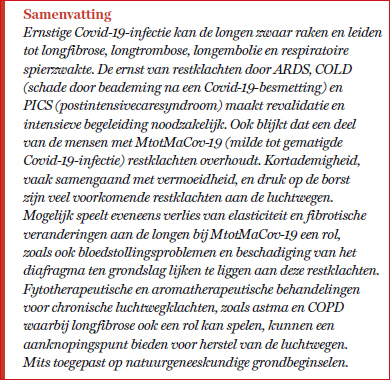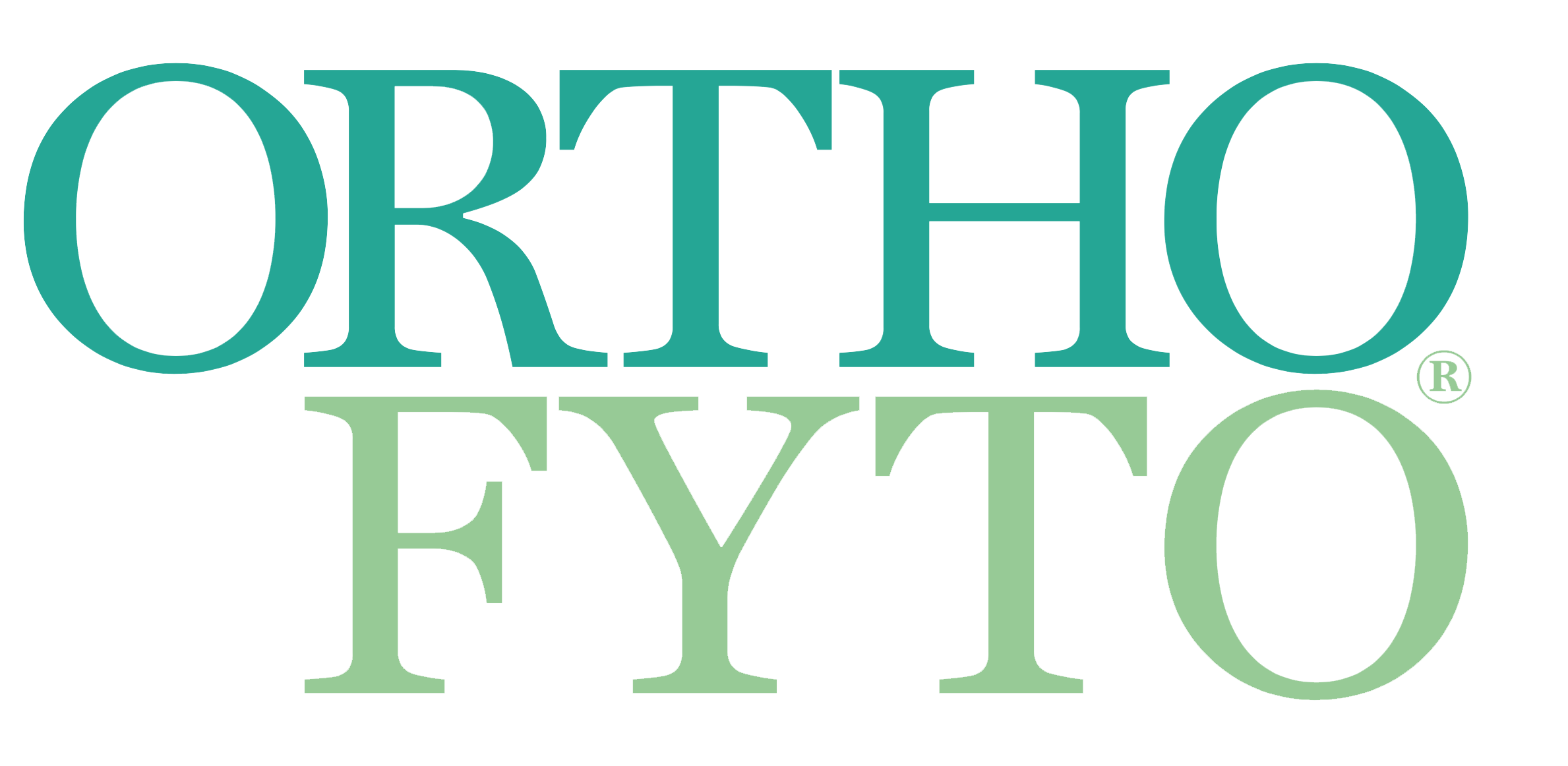Kruiden en aroma's bij longkachten na Covid-19
25 May, 2021
Door: Marilene Dols

Bij ernstige Covid-19-infectie, waarop ziekenhuis- of ic-opname volgde, is mogelijk sprake van Acute Respiratory Stress Syndrome (ARDS) waarbij kunstmatige beademing nodig is. Zo’n zware infectie kan de longen hard raken en leiden tot longfibrose, longtrombose, longembolie en respiratoire spierzwakte. Een evidence-based complementaire aanpak, waarbij uiteenlopende behandelmethoden worden toegepast, biedt perspectief voor de ernstige en langdurige restklachten.
Als gevolg van een zware Covid-19-infectie zien we vaak chronische ademhalingsproblemen en uitgebreide restklachten zoals COLD (Corona Obstructive Lung Disease), een nieuwe chronische longziekte met littekenweefsel op de longen, of PICS (Post Intensive Care Syndrome) waarbij spierzwakte, cognitieve en psychische problemen optreden na verblijf op de ic. Door de ernst van deze restklachten is revalidatie en intensieve begeleiding noodzakelijk.
Maar ook een deel van de mensen met milde tot gematigde Covid-19-infectie (verder als MtotMaCov19 aangeduid) blijkt restklachten over te houden, onder andere aan de luchtwegen.1 Kortademigheid (dyspnoe), vaak samengaand met vermoeidheid, is de meest voorkomende restklacht aan de luchtwegen na MtotMaCov19. Ook onvolledig herstel van reuk en smaak, hoest en vooral druk op de borst komen veel voor.1,2 ‘Het is alsof een olifant op mijn borst zit’ is een typering van het benauwende drukgevoel.3
Alhoewel de achtergrond van restklachten aan de luchtwegen nog niet helemaal duidelijk is, zijn er wel aanwijzingen. Mogelijk speelt verlies van elasticiteit en fibrotische veranderingen aan de longen ook bij MtotMaCov-19 een rol. Uit een kleine studie bleek dat bij 50% van patiënten met milde Covid-19-infectie Ground Glass Opacities (GGO) zichtbaar waren op een longscan. GGO zijn kenmerkend voor ontsteking van de longen en onbehandeld kan dit leiden tot verlies van elasticiteit en fibrotische veranderingen.4 Daarnaast hangen de fibrotische veranderingen mogelijk samen met de infiltratie van SARS-CoV-2 in type 2-cellen van de alveoli die rijk zijn ACE 2-receptoren. Deze ACE 2-receptoren hebben een anti-fibrotische werking op de longblaasjes die, deels, verloren gaat tijdens de Covid-19-infectie. Daarbij maken type II-alveolicellen een surfactant dat fungeert als reparatiestof bij beschadiging en zorgt voor smering van de longblaasjes waardoor een soepele gasuitwisseling mogelijk is.5 Vandaar de droge hoest met benauwdheid tijdens acute Covid-19, maar het verklaart tegelijk een vertraagd longherstel met mogelijke fibrotische verandering, óók bij MtotMaCov19.
Lees het gehele artikel vanaf pagina 28 in OrthoFyto 3/21.
Wilt u het gehele artikel als PDF bestand ontvangen? Bestel het dan hier voor € 3,50.
Bronvermelding:
1. Goërtz Y, Van Herck M, Delbressine J, et al. Persistent symptoms 3 months after a SARS-CoV-2 infection: the post-COVID-19 syndrome? ERJ Open Res 2020; in press.
2. Galal I, Aliae Hussein M, Amin M, Saad M, Eldeen H,. Zayan, Abdelsayed M. Determinants of persistent post-COVID-19 symptoms: value of a novel COVID-19 symptom score. The Egyptian Journal of Bronchology (2021) 15:10.
3. Longfonds. Klachten na corona. Geraadpleegd op 1 mei 2021 via www.longfonds.nl/corona/klachten-na-corona
4. Alschuler L, Chiasson AM, Horwitz R, et al. Integrative medicine considerations for convalescence from mild-to-moderate COVID-19 disease. [published online ahead of print, 2020 Dec 23]. Explore (NY). 2020;S1550-8307(20)30417-1.
5. Mirastschijski U, Dembinski T, Maedler K. Lung Surfactant for Pulmonary Barrier Restoration in Patients With COVID-19 Pneumonia. Frontiers in Medicine, may 2020.
6. Shi Z, de Vries H, Vlaar A, van der Hoeven J, Boon R, Ottenheijm H. the Dutch COVID-19 Diaphragm Investigators. Diaphragm Pathology in Critically Ill Patients With COVID-19 and Postmortem Findings From 3 Medical Centers. JAMA Internal Medicine January 2021 Volume 181, Number.
7. Brendler T, Al-Harrasi A, Bauer R, Gafner S, Hardy ML, Heinrich M, Hosseinzadeh H, Izzo AA, Michaelis M, Nassiri-Asl M, Panossian A, Wasser SP, Williamson EM. Botanical drugs and supplements affecting the immune response in the time of COVID-19: Implications for research and clinical practice. Phytother Res. 2020 Dec 29. doi: 10.1002/ptr.7008. Epub ahead of print. PMID: 33373071.
8. Ashraf S et al. Efficacy of honey and Nigella sativa against COVID-19: HNS-COVID-PK Trial. medRxiv, 2020.
9. Koshak A, Wei L, Koshak E et al. Nigella sativa supplementation improves asthma control and biomarkers: A randomized, double-blind, placebo-controlled trial. Phytother Res. 2017 Mar;31(3):403-409.
10. Al-Azzawi,A, AIbrahem, A, Sakrd, M. Therapeutic effects of black seed oil supplementation on chronic obstructive pulmonary disease patients: A randomized controlled double blind clinical trial. Heliyon. 2020 Aug; 6(8): e04711.
11. Boskabady M,, Farhadi J. The possible prophylactic effect of Nigella sativa seed aqueous extract on respiratory symptoms and pulmonary function tests on chemical war victims: a randomized, double-blind, placebo-controlled trial. J Altern Complement Med 2008 Nov;14(9):1137-44.
12. Yufeng Zhang , Lina Gu, Qingqing Xia, Lijun Tian, Jia Qi, Mengshu C. Radix Astragali and Radix Angelicae Sinensis in the Treatment of Idiopathic Pulmonary Fibrosis: A Systematic Review and Meta-analysis. Frontiers in Pharmacology april 2020.
13. Zhaojuan G, Siru L, Nan Zhang, Qianjun K,Huaqiang Z. Schisandra Inhibit Bleomycin-Induced Idiopathic Pulmonary Fibrosis in Rats via Suppressing M2 Macrophage Polarization. Hindawi BioMed Research International Volume 2020.
14. Tianyi Z, Mengjiao L, Yunhang G, Han L, Ling S, Hongping H, Tengfei C, Lina M, Guangping Z, Zuguang Y. Salvianolic acid B inhalation solution enhances antifibrotic and anticoagulant effects in a rat model of pulmonary fibrosis. Biomed Pharmacother. 2021 Jun;138:111475.
15. Chen J, et al. Protective roles of polysaccharides from Ganoderma lucidum on bleomycin-induced pulmonary fibrosis in rats. Int J Biol Macromol. 2016;92:278-281.
16. Guo-Sheng Gu, Jian-An Ren, Guan-Wei Li, Yu-Jie Yuan, Ning Li, Jie-Shou Li. Cordyceps sinensis preserves intestinal mucosal barrier and may be an adjunct therapy in endotoxin-induced sepsis rat model: a pilot study. Int J Clin Exp Med 2015 May 15;8(5):7333-41. eCollection 2015.
17. Mingliang J, Yimin Z, Dongyan S, Ke Z, Chunlan X, Qi L, Hui Y, Qingsheng Huang 2, Junling Shi 2. Effects of polysaccharide from mycelia of Ganoderma lucidum on intestinal barrier functions of rats. Int J Biol Macromol 2017 Jan;94(Pt A):1-9.
18. Budden KF, et al. Emerging pathogenic links between microbiota and the gut–lung axis. Nature Reviews Microbiology, 2017, 15.1: 55-63.
19. Bingula R, et al. Desired turbulence? Gut-lung axis, immunity, and lung cancer. Journal of oncology, 2017.
20. Dumas A, et al. The role of the lung microbiota and the gut–lung axis in respiratory infectious diseases. Cellular microbiology, 2018, 20.12: e12966.
21. Yunyoung K, Dong-Min K, Ji Yeon K. Ginger Extract Suppresses Inflammatory Response and Maintains Barrier Function in Human Colonic Epithelial Caco-2 Cells Exposed to Inflammatory Mediators. J Food Sci 2017 May;82(5):1264-1270.
22. Jiao S, Xin L, Jingxian L, Nadia E, Guiping Z, Jie W, Ye Y. The effect of Epigallocatechin-3-gallate on small intestinal morphology, antioxidant capacity and anti-inflammatory effect in heat-stressed broilers. J Anim Physiol Anim Nutr (Berl) . 2019 Jul;103(4):1030-1038. doi: 10.1111/jpn.13062. Epub 2019 Jan 31.
23. Chapman H, et al. Reversal of TGFβ1-driven profibrotic state in patients with pulmonary fibrosis. N Engl J Med. 2020;382(11):1068-70.
24. Lan Kiauw de Munck-Khoe. De curcumineparadox, veelzijdige werking ondanks slechte biologische beschikbaarheid. Ned. Tijdschrift voor Fytotherapie, 2019 nr3.
25. Yazdi F, Soleimanian-Zad S, van den Worm E, Folkerts G. Turmeric Extract: Potential Use as a Prebiotic and Anti-Inflammatory Compound? Plant Foods Hum Nutr 2019 Sep;74(3):293-299.
26. Cole G, Teter B, Frautschy S. Neuroprotective effects of curcumin. Adv Exp Med Biol 2007;595:197-212.
27. Thomas H, J Nikles. Herbal Medicines Used in the Treatment of Chronic Insomnia and How They Influence Sleep Patterns: A Review. J Complement Med Alt Healthcare .2018; 6(1).
28. Lorena R. Lizarraga-Valderrama. Effects of essential oils on central nervous system: Focus on mental health. Phytotherapy Research. 2021;35:657–679.
29. Shirley Price & Len Price. Aromatherapy for Health Professionals. (4th edition), Elsevier Churchill Livingstone. 2012. ISBN 9780702059681
